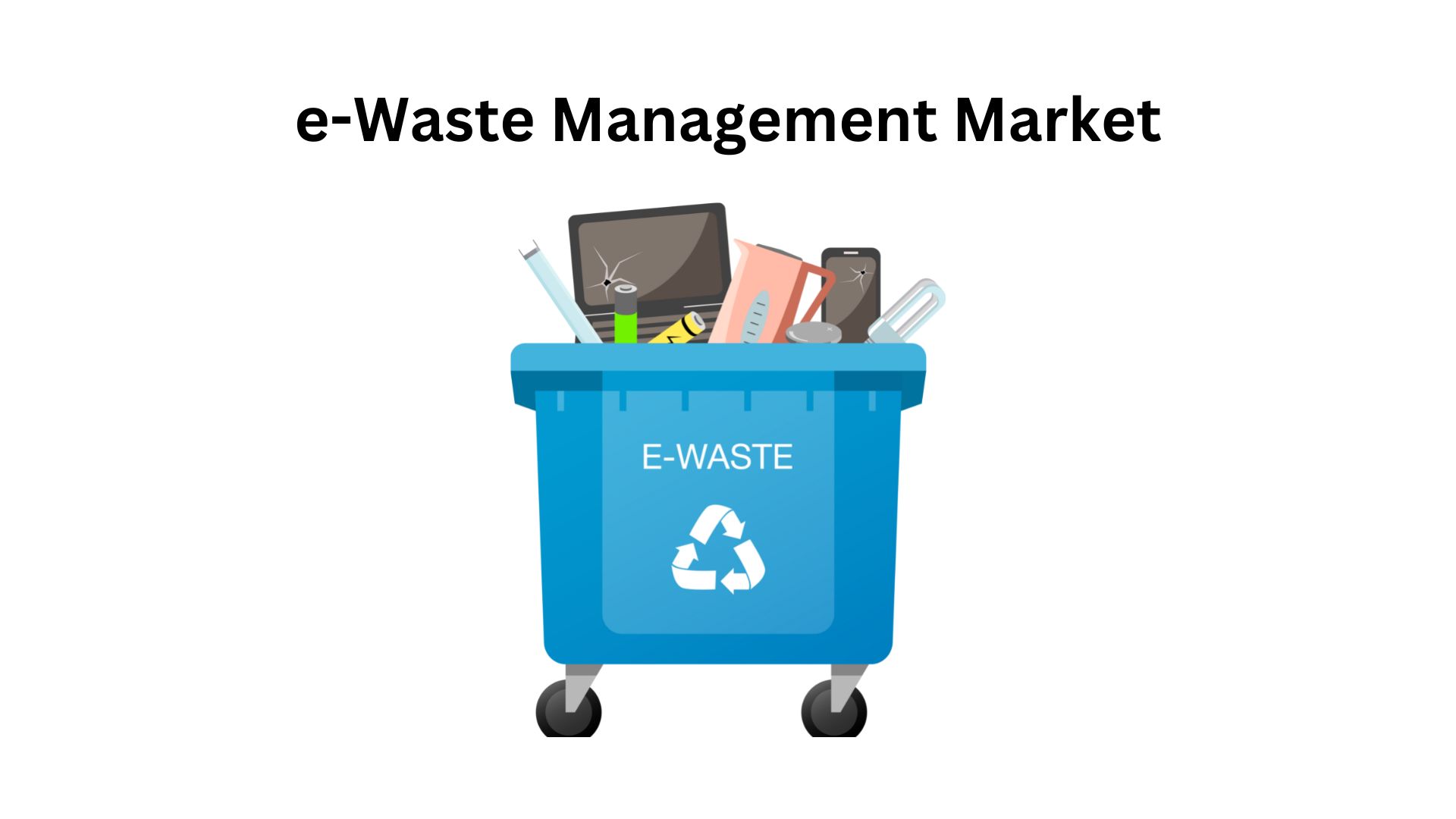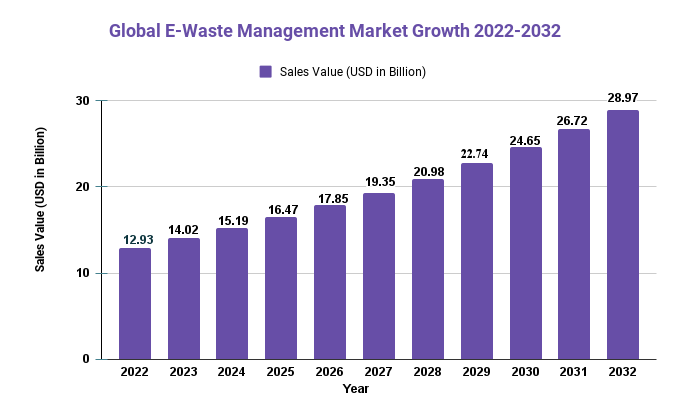Global E-Waste Management Market Size 28.97 bn + Factor Analysis by 2032

Page Contents
Market Overview
The global E-Waste Management market has been growing steadily in recent years and is expected to continue growing in the coming years. E-waste, or electronic waste, refers to discarded electronic devices such as computers, televisions, smartphones, and other electronic equipment. The management of e-waste involves the collection, transportation, processing, and disposal of electronic devices in a safe and environmentally-friendly manner.
According to a report by Market.us Research, the global e-waste management market size was valued at USD 12.93 billion in 2022 and is expected to grow at a compound annual growth rate (CAGR) of 8.4% from 2022 to 2032.
This growth is primarily driven by the increasing generation of e-waste due to the rapid pace of technological advancements and the increasing adoption of electronic devices globally.
Regionally, North America held the largest market share in 2020, followed by Europe and the Asia Pacific. The Asia Pacific region is expected to witness the highest growth rate due to the increasing urbanization and industrialization in countries such as China and India, which is leading to an increase in the generation of e-waste.
We Have Recent Updates on the Market in Sample Copy@ https://market.us/report/container-shipping-market/request-sample
Key Takeaway
- The global market for E-Waste Management is expanding at an impressive rate, driven by the increasing generation of electronic waste due to technological advancements and the widespread adoption of electronic devices.
- From 2021-2028, the market is projected to experience a compound annual growth rate (CAGR) of 8.4%.
- North America held the largest market share in 2020, followed by Europe and Asia Pacific. The latter region is expected to experience the highest growth rate due to increasing urbanization and industrialization rates.

Regional Snapshot
- North America: The e-waste management market in North America is expected to expand due to the high adoption of technology and an ever-increasing number of electronic devices being used by individuals and businesses alike. North America accounts for most of the generated e-waste in this region, particularly from the United States and Canada.
- Europe: The e-waste management market in Europe is well established and strictly regulated, with the European Union enforcing several directives for electronic waste management. Countries like Germany, France, and the UK account for much of this generated electronic waste in the region.
- Asia Pacific: The e-waste management market in Asia Pacific is expected to experience substantial growth due to the high volume of electronic waste generated in countries like China, India, and Japan. The rapid adoption of technology and expanding population are major contributors to this region's e-waste production.
- Latin America: The e-waste management market in Latin America is forecasted to expand due to an increasing number of electronic devices being used by individuals and businesses alike. Countries such as Brazil, Mexico, and Argentina are major sources of this region's e-waste generated.
- Middle East and Africa: The e-waste management market in the Middle East and Africa is anticipated to expand due to increasing technology adoption and an expanding population in countries like Saudi Arabia, South Africa, and the United Arab Emirates. Unfortunately, the lack of appropriate regulations and infrastructure in some countries may hinder market expansion throughout this region.
Market Dynamics
Drivers
- Increased Electronic Waste: With the growing adoption of electronic devices such as smartphones, laptops, and tablets comes an inevitable rise in electronic waste generation. This poses major environmental and health risks that must be managed properly for these reasons.
- Stringent Regulations: Governments around the world have implemented stringent regulations for e-waste management to reduce its environmental impact. As a result, there has been an uptick in demand for e-waste management services.
- Increased Awareness: People are becoming increasingly aware of the environmental harm caused by electronic waste and are taking steps to properly dispose of their devices. This has created a demand for e-waste management services.
- Growing Demand for Recycled Products: As people become more environmentally aware, the demand for recycled goods is on the rise. To properly recycle these items, proper e-waste management services are necessary – which is driving growth in this market.
- Technological Advancements: Technological progress has enabled the development of advanced and more efficient e-waste management techniques, creating opportunities for companies operating in this market to provide innovative and sustainable solutions.
Restraints
- Lack of Awareness: Although awareness about the negative consequences of electronic waste is growing, many still do not comprehend its critical significance for proper e-waste management. This lack of comprehension could potentially stifle growth in this market.
- High Costs: E-waste management encompasses several steps, such as collection, transportation, sorting, recycling, and disposal. Unfortunately, these tasks can be expensive which makes e-waste management services unattainable for some individuals and organizations.
- Lack of Infrastructure: Effective e-waste management requires adequate infrastructure, such as collection centers, recycling plants, and disposal facilities. Unfortunately, many countries lack these essential elements which could restrict growth in the e-waste management market.
- Technological Limitations: Although advances in technology have enabled the development of advanced e-waste management techniques, there remain technical obstacles that may restrict market expansion. For instance, some electronic devices cannot be recycled due to materials used during their manufacturing.
- Absence of Appropriate Regulations: While some countries have implemented stringent regulations for e-waste management, many others lack such oversight. This can result in improper disposal of electronic waste which has an adverse impact on both environmental quality and human health.
Opportunities
- Government Initiatives: Governments around the world are taking action to manage e-waste efficiently. These initiatives present businesses with an opportunity to collaborate with these government bodies and offer e-waste management services.
- Growing Awareness: Consumers are becoming more and more aware of the damaging effects of electronic waste on both the environment and human health. This has resulted in an uptick in demand for e-waste management services.
- Recycling Technologies: Advanced technologies are being created to recycle electronic waste more effectively and sustainably. E-waste management companies can invest in these initiatives to offer creative recycling solutions.
- Circular Economy: The circular economy concept is becoming increasingly popular, encouraging reuse and recycling materials in order to reduce waste. E-waste management companies can play an essential role in creating this circular economy by offering efficient and sustainable e-waste management solutions.
- Urbanization: The rapid urbanization in developing countries has resulted in an increase in electronic waste generation. E-waste management companies can benefit from this growing market by offering services to urban areas.
View Detailed TOC of the Report | https://market.us/report/e-waste-management-market/table-of-content/
Challenges
- Lack of Awareness: Despite growing awareness about the damaging effects of e-waste, there remains a lack of understanding among many consumers as to how best to dispose of their electronic devices.
- Illegal Dumping: Illegal dumping of e-waste remains a serious problem, particularly in developing countries due to the absence of an effective management infrastructure and effective enforcement of regulations.
- Cost: E-waste management can be costly due to the intricate materials involved, as well as transportation and processing fees. This makes it challenging for companies to offer budget-friendly solutions.
- Data Security: E-waste management involves handling sensitive data which could be compromised if not handled correctly. This presents a major challenge for companies providing these services in this space.
- Regulatory Environment: Regulations regarding e-waste management can differ significantly between countries, making it challenging for businesses to navigate the legal landscape.
- Lack of Infrastructure: Developing countries often lack the necessary infrastructure to effectively manage e-waste, including recycling facilities and proper waste disposal sites.
Key Market Segments
Type
- Copper
- Plastic resins
- Steel
Application
- Consumers/residential
- Manufacturers/Industry users
- Government agencies
- Schools/universities
- Commercial
Key Market Players
- Aurubis AG (Germany)
- Boliden AB (Sweden)
- Electronic Recyclers International Inc. (U.S.)
- Sims Metal Management Ltd. (Australia)
- Umicore S.A. (Belgium)
- Stena Technoworld AB (Sweden)
- Enviro-Hub Holdings Ltd. (Singapore)
- Global Electric Electronic Processing Inc. (Canada)
- MBA Polymers Inc. (California)
Report Scope
| Report Attribute | Details |
| The market size value in 2022 | USD 12.93 Bn |
| Revenue forecast by 2032 | USD 28.97 Bn |
| Growth Rate | CAGR Of 8.4% |
| Regions Covered | North America, Europe, Asia Pacific, Latin America, and Middle East & Africa, and Rest of the World |
| Historical Years | 2017-2022 |
| Base Year | 2022 |
| Estimated Year | 2023 |
| Short-Term Projection Year | 2028 |
| Long-Term Projected Year | 2032 |
Frequently Asked Question
Q: What is the current market size for the Global E-Waste Management Market?
A: According to a report by Market.us, the Global E-Waste Management Market was valued at USD 12.93 billion in 2022 and is expected to reach USD 28.97 billion by 2032, growing at a CAGR of 8.4% during the forecast period.
Q: What are the key segments of the Global E-Waste Management Market?
A: The Global E-Waste Management Market can be segmented based on type (Copper, Plastic resins, Steel), application (Consumers/residential, Manufacturers/Industry users, Government agencies, Schools/universities, Commercial), and geography (North America, Europe, Asia-Pacific, Latin America, and Middle East & Africa).
Q: Who are the key players in the Global E-Waste Management Market?
A: Some of the key players in the Global E-Waste Management Market include Aurubis AG (Germany), Boliden AB (Sweden), Electronic Recyclers International Inc. (U.S.), Sims Metal Management Ltd. (Australia), Umicore S.A. (Belgium), Stena Technoworld AB (Sweden), Enviro-Hub Holdings Ltd. (Singapore), Global Electric Electronic Processing Inc. (Canada), MBA Polymers Inc. (California).
The team behind market.us, marketresearch.biz, market.biz and more. Our purpose is to keep our customers ahead of the game with regard to the markets. They may fluctuate up or down, but we will help you to stay ahead of the curve in these market fluctuations. Our consistent growth and ability to deliver in-depth analyses and market insight has engaged genuine market players. They have faith in us to offer the data and information they require to make balanced and decisive marketing decisions.